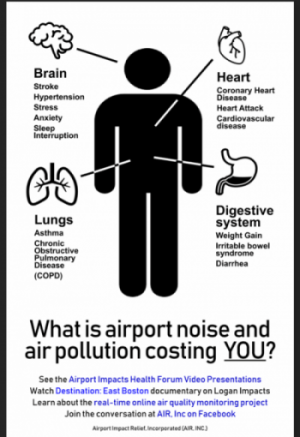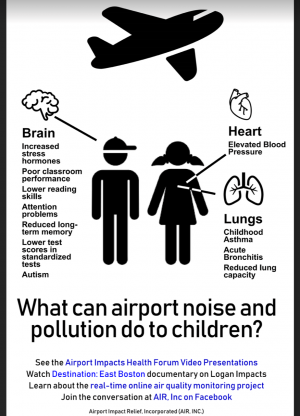
Summit to bring together communities, researchers and policymakers to develop solutions that promote health and well-being in airport communities
"If you want to learn about the health of a population, look at the air they breathe, the water they drink, and the places where they live." – Hippocrates
GO TO: Summit Goals | Event Details | Summit Topics | Collaborators | Contact us | Solution Teams
Summit Goals
Establish national and international dialogue between community leaders, researchers and public officials to share solutions and strategies targeted at reducing the impacts of aircraft traffic on health and the environment. Participants will share success stories, unique implementations barriers and knowledge gaps that surround the complex issue of environmental exposures in airport adjacent communities. Summit participants will also work to identify resilience strategies. Proceedings of the Summit will be shared and disseminated with stakeholders. Both short-term and long-term solutions will be discussed and developed over the course of the summit. Participants will work in teams to identify facilitators and barriers to implementing proposed solutions as well as establish partnerships likely to lead to success.
Event Details
WHEN: Friday, June 18, 8:00-10:00 AM (Pacific Time) and Saturday, July 17, 8:00 AM- 2:00 PM (Pacific Time), 2021
A link to the zoom meeting will be e-mailed to all registrants on Thursday afternoon and Friday morning in advance of the event. Please check your spam folder or e-mail lhayward@uw.edu if you do not receive an e-mail by Thursday evening Pacific Time.
AGENDA:
Speakers and Agenda for the June Event
Speakers and Agenda for the July Event
More information about the July Event
HOW: Livestreamed event with workshop and breakout sessions throughout the day.
WHAT: A virtual event to talk about the impact of the aviation industry on people and the planet and promote solutions.
REGISTRATION: Registration is free.
View a recording of the July 17th 2021 meeting:
View a recording of the June 18th 2021 meeting:
Summit Topics
- Social justice
- Human health impacts
- Engaging stakeholders
- Indoor environment
- Outdoor exposures
- Impacts on children
- Developing effective partnerships
Collaborators
- Representative Adrian Madaro, Massachusetts
- Representative Tina Orwall, Washington
- Mira's Garden
- University of Washington EDGE Center
- Olin College
- Mothers out Front, East Boston
Contact us
Community Lead: Debi Wagner
Academic Advisor: Elena Austin
Assistant Professor
University of Washington
Solution Teams and Resources
Aviation Impacts Solutions Summit:
Empowering at-risk communities by democratizing air quality data (East Boston)
Air pollution is the largest environmental health risk in the world, according to the World Health Organization, and very few at-risk communities have access to local air quality data or strategies to mitigate health risks. Learn about this air quality project and Mothers Out Front - East Boston.
Air quality, noise and health
There are ongoing research studies designed to quantify impacts of air craft emissions and noise on health. Air Impact Relief INC, an East Boston-based environmental group, has developed the following infographics describing the impacts and costs of aircraft emission on health. These impacts were identified through collaborative partnerships and in the future they aim to work toward solutions.
Mira's Garden
Mira’s Garden is a nonprofit organization based in the State of Washington dedicated to providing a healthy environment for schools, strengthen community and social justice initiatives. Current projects include participating in organizing the Airport Communities Summit, supporting the UW DEOHS Healthy Schools; Healthy Air project and the National Dream Day.
Mira's Garden Organization is currently undertaking a Drive to D.C. to Stop Aviation Air & Noise Pollution. Kent Palosaari and his daughter Mira will be making the trip from July 9th to July 29th, 2021.
Press release about the Drive to DC
The MOV-UP study
The Mobile ObserVations of Ultrafine Particles (MOV-UP) study analyzed the potential air quality impacts of ultrafine pollution particles from aircraft traffic on communities near and underneath Seattle-Tacoma International Airport (Sea-Tac) flight paths. This two-year study, which ended in December 2019, was funded by the Washington State Legislature to assess ultrafine pollution particles within 10 miles of the airport in the direction of aircraft flight. The study was led by the UW Department of Environmental & Occupational Health Sciences and the Department of Civil and Environmental Engineering.
Download the report Policy brief Media coverage Past project updates
Community Health and Airport Operations Related Noise and Air Pollution
This report responds to a proviso in Washington state’s House Bill 1109 which requests that Public Health – Seattle & King County produce a) airport community health profiles for a one-mile, a five-mile, and a 10-mile radius of the airport; b) a comprehensive literature review assessing the strength-of evidence for health effects of airport operations; c) a summary of findings of the University of Washington School of Public Health study on ultrafine particulate matter; and d) recommendations to address health issues related to the impact of the airport on the community. The purpose is to understand the community health effects of pollution related to Seattle-Tacoma International Airport (SeaTac) operations.
Primary findings of this report included that airport communities have higher rates of pervasive health concerns. Compared to the rest of the county, communities within 10 miles of SeaTac report:
- A greater percentage of infants born prematurely and/or with low birthweight;
- Higher hospitalization rates for asthma, stroke, chronic obstructive pulmonary disease (COPD), heart disease, and diabetes;
- Lower life expectancy; and
- Higher rates of death overall, as well as death from heart disease, unintentional injury, chronic lower respiratory disease, diabetes, chronic liver disease, and homicide.
In several measures, the rates of poor health outcomes were worse the closer you are to the airport. For example:
- Higher hospitalization rates for heart disease;
- Higher rate of death from all causes;
- Higher rate of death from heart disease; and
- Lower life expectancy.
Life Under Flight
Growing bodies of research indicate that living near an airport can lead to adverse health conditions. The main culprits are noise and air pollution, which have shown to affect individuals who live miles away from airports.
The 10-mile radius surrounding these airports is not meant to suggest residents within this area experience a defined level of risk and those outside the circle do not. Rather, it is meant to show the large population of people that may be at risk, living near major airports. 10% of the U.S. population lives within 10 miles of the top 23 airports. Millions more live near other airports.
Click on each aircraft logo to learn more about the airport and demographics of the community within the 10-mile radius.
Passenger data from individual airport reports and the Port Authority of NY/NJ 2019 Air Traffic Report Operations data from individual airport reports and the FAA’s Air Traffic Activity System Demographic data from The EPA’s Environmental Justice Screening and Mapping Tool, as well as FreeMapTool’s population inside an area search map
Map created by Matt Heller. Special thanks to Richard Kujawa, PhD, professor of geography at Saint Michael’s College, for support with map creation and adaptation.


